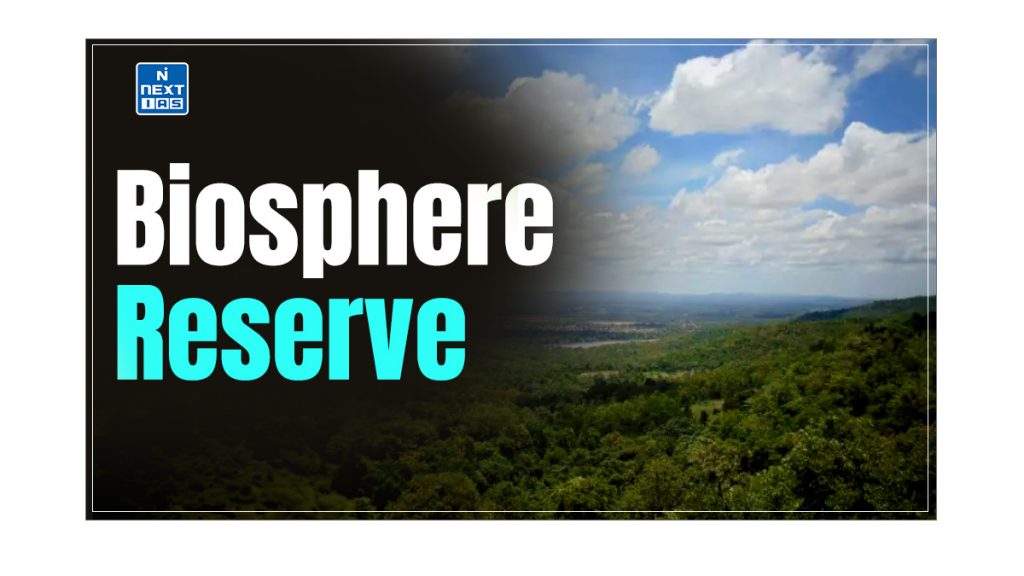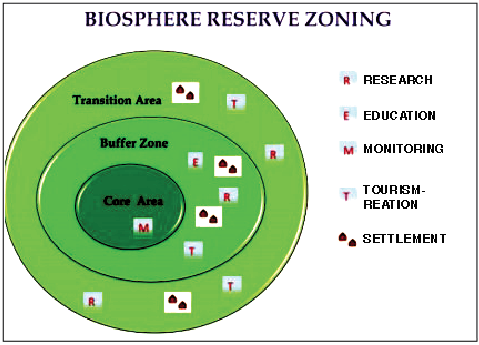
Biosphere Reserve (BR) offers a promising model for reconciling conservation with development. By promoting sustainable practices and involving local communities, they can contribute to human well-being and environmental protection. This article aims to study in detail the concept of Biosphere Reserve (BR), its meaning, criteria for designation, structure and other related concepts.
What is Biosphere Reserve (BR)?
- A Biosphere Reserve (BR) is an area of terrestrial, marine and coastal ecosystems that promote the conservation of biodiversity with its sustainable use.
- They are integral components of the internationally recognized framework of UNESCO’s Man and Biosphere (MAB) programme initiated in 1971 and they are nominated by national Governments.
- There are more than 500 such reserves spread across over 100 countries worldwide.
Criteria for Designation as Biosphere Reserve
- The core area should be typical of a bio-geographical unit and large enough to sustain viable populations representing all trophic levels in the ecosystem.
- A site that must contain an effectively protected and minimally disturbed core area of value of nature conservation.
- Areas potential for preservation of traditional tribal or rural modes of living for harmonious use of the environment.
- The management authority to ensure the involvement/cooperation of local communities to bring a variety of knowledge and experiences to link biodiversity conservation and socio-economic development while managing and containing the conflicts.
Structure of Biosphere Reserve
A Biosphere Reserve (BR) consists of 3 zones – Core Zone, Buffer Zone, and Transition Zone.

Core Zone
- Core Zone must contain suitable habitat for a range of plant and animal species, including higher order predators and may contain centres of endemism.
- Core area is a legally protected area where human intervention is strictly prohibited.
- It also represent important genetic reservoirs having exceptional scientific interest.
- A core zone being mostly protected under the Wildlife (Protection) Act, 1972.
Buffer Zone
- The buffer zone surrounds the core zone.
- The uses and activities are managed in this area in ways that help protect the core zone in its natural condition.
- These uses and activities include restoration, limited recreation, tourism, fishing, grazing, demonstration sites for enhancing value addition to the resources, etc; which are permitted to reduce their effect on the core zone.
- Research and educational activities are to be encouraged.
- Human activities for research and educational purposes within the Reserve are likely to continue if these do not adversely affect the ecological diversity and conservation objectives.
Transition Zone
- It is the outermost part of a reserve, and is usually not a delimited zone.
- This is a zone of cooperation where management skills and conservation knowledge are applied to ensure that uses are in harmony with the purpose of the reserve.
- This includes managed forests, settlements, crop lands, and area for intensive recreation and other economic uses characteristics of the region.
Biosphere Reserve Vs National Park & Wildlife Sanctuary
| National Park/Wildlife Sanctuary | Biosphere Reserve |
|---|---|
| National Parks, Wildlife Sanctuaries, Conservation Reserves, Community Reserves and Tiger Reserves are established as per provisions of the Wildlife Protection Act, of 1972 | There is no law as such under which these Reserves are established. |
| No grazing or private tenurial rights land rights are allowed in National Parks. | Biosphere reserves serve as ‘living laboratories’ for testing out and demonstrating integrated management of land, water and biodiversity. Thus, limited economic activity (sand and stone mining) is permitted |
| Wildlife sanctuaries and national parks are set up for the protection of mammals normally | They envisage protection of plant species, Invertebrates and biotic community as a whole |
Conclusion
The concept of Biosphere Reserve (BR) represents a forward-thinking approach to conservation, balancing the needs of nature and human development. They are crucial for preserving biodiversity, fostering sustainable practices, and serving as hubs for research and education. By addressing the challenges and leveraging the opportunities they present, these reserves can significantly contribute to global efforts toward environmental sustainability and human well-being.
Biosphere Reserves in India
- There are 18 notified Biosphere Reserves (BRs) in India.
- Out of them, 12 are included in UNESCO’s MAB World Network, which are listed as follows:
- Nilgiri (2000)
- Gulf of Mannar (2001)
- Sunderban (2001)
- Nanda Devi (2004)
- Nokrek (2009)
- Pachmarhi (2009)
- Similipal (2009)
- Achanakmar-Amarkantak (2012)
- Great Nicobar (2013)
- Agasthyamala (2016)
- Khangchendzonga, Sikkim (2018), and
- Panna, Madhya Pradesh (2020)
Frequently Asked Questions (FAQs)
What is the Man and Biosphere Programme?
The Man and Biosphere Programme (MAB) is a UNESCO intergovernmental scientific programme that aims to establish a world network of biosphere reserves to promote sustainable development based on sound ecological principles.
What is the World Network of Biosphere Reserves?
It is a global network established by the Man and Biosphere Programme (MAB) under UNESCO.
Which is the only marine biosphere reserve in India?
The Gulf of Mannar (Tamil Nadu) is the only marine biosphere reserve in India.






